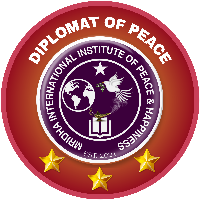The format for MIIPH courses is that each lesson consists of three (3) lessons. At the end of Lessons 1 and 2, you will be asked a short discussion question designed to get you thinking about the concepts in each lecture. There is a quiz at the end of Lesson 3 that you must pass to move to the next lesson.
To earn your star and graduate to the next level, you must score at least 80% (8 out of 10 correct answers). You can take the test up to three times within 24 hours. If you still have not passed after your third try, you can try again after 24 hours. You can take the test as many times as you need to in order to pass. Persistence is rewarded: Nobody flunks out of MIIPH!
Friend of Peace | Course : 1 | Introducing Peace

Course 1 takes a broad view to define basic terms such as peace, conflict, and forgiveness. Do you know the difference between negative peace and positive peace? This course provides clear, concise definitions of these and other terms while also establishing the importance of establishing inner peace on the journey to external peace with others.
Advocate of Peace | Course : 2 | The Nature of Conflict

Course 2 explores the types, root causes, and likely outcomes of conflict, both on the world stage and scaled down to your community and even one-on-one interpersonal relationships. You will discover the similarities and differences of each dynamic, and you will develop skills to successfully interpret the signals and indicators of potential conflict. As a result, you will be better prepared to successfully address conflict with a positive mindset geared toward peaceful and positive resolution.
Diplomat of Peace | Course : 3 | Getting (Pro) Active For Peace

Course 3 offers a broad introduction to peace in the physical world. This includes tools and activities for increasing personal/inner peace and promoting peace as an example in your community. We explore the relationship of peace and happiness by posing questions such as, “Are peace and happiness mutually exclusive?” “Can you truly have one without the other?” and “How do you maintain the balanced partnership between the two?” We also examine the dynamics of adversarial relationships and offer insight and instruction on positive, inclusive community activism.
Ambassador of Peace | Course : 4 | Instruments of Peace

Course 4 builds on concepts from Courses 1, 2, and 3, providing additional context and guidance to help you find peace in YOUR purpose. Tapping into a peaceful state through music, whether through an instrument, your voice, or just listening, can be an enriching experience that affects other areas of your life in a positive way. Manifesting peace is the desired endgame of promoting peace, which we explore in more depth in Lesson 3.
Visionary of Peace | Course : 5 | Peaceful Intentions

Course 5 lifts you up through the debris of years of human existence marked by conflict to visualize the apex of human evolution: a peaceful mindset nestled in a tranquil destination. The concepts may seem unrealistic at first, but once you liberate yourself from old, outed ways of seeing the world, you will be able to apply these lessons directly into your own life and enrich your community by doing so. The journey is yours to take.

